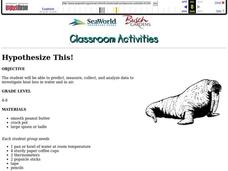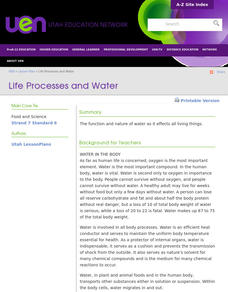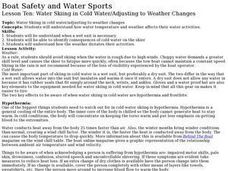University of Minnesota
Homeostasis of Thermoregulation
Whether you're battling the flu or trying to warm up on a chilly day, your body's ability to react to temperature change is fascinating! Anatomy scholars discover the fantastic feedback loops that control body temperature in a rigorous...
Virginia Department of Education
Heat Loss from a Fur-Insulated Animal
How do animals adapt to weather changes? Provide your class with the ability to understand adaptations and body temperature as they participate in this hands on experiment, using fake fur and hot water. Pupils collect data and analyze...
Texas State Energy Conservation Office
Investigation: Heat it Up!
This demonstration of solar ponds can be used in an earth, environmental, or physical science setting. Lab groups set up a solar pond and model how it is able, due to a salt concentration gradient, to maintain heat for future use.
Curated OER
Heating and Cooling a Really Large Lizard
Remind your middle school scientists how fox ear size varies depending on the climate they live in; large ears allow heat loss while small ears keep heat in. Discuss how a cold-blooded animal might try to regulate body temperature. Then...
Curated OER
Maintaining Body Heat
Students observe and compare heat loss in various objects with surface area-to-volume ratios and transfer this comparison to the physical characteristics of animals in their environment. In small groups they conduct an experiment...
Curated OER
Maintaining Body Heat
Students observe and compare heat loss in different objects with surface-to-volume ratios. They transfer this comparison to the physical characteristics of animals in their environment. They focus on how whales maintain their body heat.
It's About Time
Energy Flow in Ecosystems
Emerging biochemists more fully understand the flow of energy in ecosystems as they explore the laws of thermodynamics and relate them to energy transfer in food chains. They also investigate heat loss from the human body and how...
American College of Sports Medicine
Selecting and Effectively Using Hydration for Fitness
How much water does your body lose during exercise? How much should you hydrate during and after exercise? Address the importance of hydration with your young athletes using this informative handout.
American Chemical Society
Keeping Warm in the Cold
Bundle up to stay warm! A fun-filled investigation opens with a group discussion about heat loss and using materials to prevent it. Young scientists then view an animation about thermometers and the Celsius scale and practice reading...
Curated OER
Preventing Hypothermia
Students identify the causes of hypothermia. In this biology lesson, students investigate the different types of heat transfer and heat loss. They discuss several practical measures to avoid hypothermia.
Curated OER
HYPOTHESIZE THIS!
Learners predict, measure, collect, and analyze data to investigate heat loss in water and in air.
Curated OER
Hypothesize This!
Students role play scientists to prove a hypotheses. They determine whether or not walruses stay warmer in water or in air. Students also determine in which environment they lose more body heat.
Curated OER
Go With the Flow!
Learners experiment with heat transfer in a countercurrent system and describe the importance of conduction in heat-energy transfer.
Curated OER
Integumentary System: A System, An Organ, the Biggest!
It is only six short slides, but an acceptable outline of the integumentary system. General facts about the system, layers, sublayers, and functions are listed as bullet-points. What would make this presentation more engaging for your...
Curated OER
4-H Advanced Food Science Activity Pages
In this 4-H food science worksheet, learners examine how food works in the body, find out about food preservation methods, and investigate careers in the food industry. They complete a word search, practice food photography, answer true...
Curated OER
(S-1) Sunlight and the Earth
Students discuss the solar heating of the Earth and atmosphere, its heat loss proceses, and the way these relate to weather and climate.
Curated OER
Life Processes and Water
Explain the properties of water. Identify the properties of water that make it a polar molecule Describe hydrogen bonds and how they differ from covalent bonds Discuss the differences between hard water and soft water Compare the heat of...
Curated OER
Nutrition
For this nutrition worksheet, students describe what nutrient is and how the energy it has is measured. Then they explain what is meant by interconversion of molecules. Students also list the common vitamins and mineral required by the...
Curated OER
Why Don't Whales Have Legs?
Students are given a variety of materials and are asked to design a heat loss experiment that results in a reasonable explanation of "Why don't whales have legs?" students work with the theory of natural selection.
Curated OER
The Shape of Things
Sixth graders read and discuss information regarding the shape and attributes of an eggshell. For this shape of things lesson, 6th graders gather relevant information that pertains to the incubation and formation of an eggshell. ...
Curated OER
The Shape of Things
Students study the natural incubation of hens and the important characteristics of the egg shell. They perform experiments to test the strength of the dome shape of an egg and prove that an eggshell has pores to allow air to pass. ...
Curated OER
The Shape of Things
Students explore dome shape construction. In this dome shape construction lesson, students explore the history, strength, and endurance of the dome shape design.
Curated OER
Boat Safety and Water Sports - Lesson 10 - Cold Water/Weather
Lesson 10 is part of a twenty-two lesson unit on boat safety and water sports. It focuses on how to handle cold water and cold weather when water skiing, as well as what to do if hypothermia or frostbite occur. Click on the resource link...
Curated OER
Introduction to Applied Maximum Minimum Problems
Twelfth graders solve problems by finding the maximum and minimum. In this calculus lesson, 12th graders analyze certain animals identifying their maximum and minimum points. They also use bubble as part of their real world application...

























